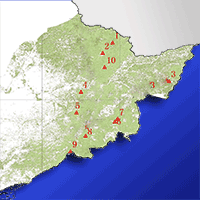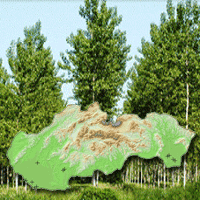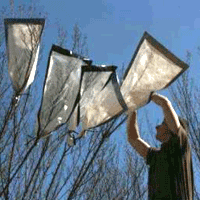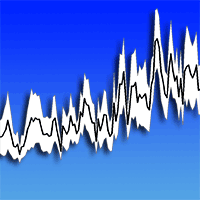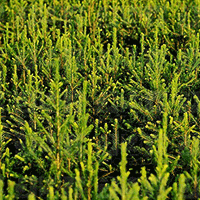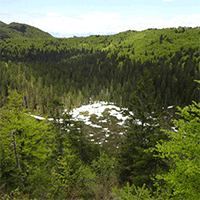
Tree aging does not affect the ranking for water use efficiency recorded from δ13C in three Populus deltoides × P. nigra genotypes
Fahad Rasheed (1-2) , Erwin Dreyer (1-3), Didier Le Thiec (1-3), Zikria Zafar (2), Sylvain Delagrange (4)
iForest - Biogeosciences and Forestry, Volume 12, Issue 3, Pages 272-278 (2019)
doi: https://doi.org/10.3832/ifor2896-012
Published: May 21, 2019 - Copyright © 2019 SISEF
Research Articles
Abstract
A large variability of water use efficiency (assessed from the carbon isotopic discrimination in leaves and leaf soluble sugars) has been detected among poplar genotypes. Checking whether such differences detected in young trees (1-2 years old) remain stable with tree age is a prerequisite to use this trait with confidence for breeding purposes. In this study, a synchronic approach was used to test the age-related stability of the genotypic ranking of carbon isotopic discrimination in wood (Δ13C) until tree maturity. We sampled 376 trees between 4 and 20 years from three Populus deltoides × P. nigra genotypes growing in 41 common-garden trials across France. Carbon and nitrogen percentages along with δ13C was measured in the bulk wood of the year 2009 and used to compute the Δ13C. Basal area increment between 2008 and 2009 was also measured. Results showed that Δ13C increased (i.e., water use efficiency decreased) between ages 4 to 6 and remained stable later on. Significant differences among genotypes were found but the ranking among genotypes remained stable with age during the assessed life span. Furthermore, basal area increment and Δ13C were positively correlated interannually. This large-scale survey shows that despite crossing over in the temporal trend, water use efficiency remained stable with age across 3 poplar genotypes. However, further studies with a large number of genotypes are required to confirm whether this trait can be used to maintain or even improve productivity of poplar plantations, while lowering water consumption.
Keywords
Water Use Efficiency, Age, Wood, Tree Ring, Populus × euramericana, Basal Area Increment, Synchronic Approach
Authors’ Info
Authors’ address
Erwin Dreyer 0000-0003-4999-5072
Didier Le Thiec 0000-0002-4204-551X
INRA, UMR1137 Ecologie et Ecophysiologie Forestières, IFR 110 EFABA, F-54280 Champenoux (France)
Zikria Zafar 0000-0001-8881-7653
Department of Forestry & Range Management, University of Agriculture Faisalabad, P.O. Box 38000 (Pakistan)
Didier Le Thiec 0000-0002-4204-551X
Université de Lorraine, UMR1137 Ecologie et Ecophysiologie Forestières, IFR 110 EFABA, F-54500 Vandoeuvre-lès-Nancy (France)
Department of Natural Sciences, Institute of Temperate Forest Sciences (ISFORT), University of Quebec in Outaouais (UQO), 58 Main St, Ripon, Quebec J0V 1V0 (Canada)
Corresponding author
Paper Info
Citation
Rasheed F, Dreyer E, Le Thiec D, Zafar Z, Delagrange S (2019). Tree aging does not affect the ranking for water use efficiency recorded from δ13C in three Populus deltoides × P. nigra genotypes. iForest 12: 272-278. - doi: 10.3832/ifor2896-012
Academic Editor
Rossella Guerrieri
Paper history
Received: Jun 15, 2018
Accepted: Mar 18, 2019
First online: May 21, 2019
Publication Date: Jun 30, 2019
Publication Time: 2.13 months
Copyright Information
© SISEF - The Italian Society of Silviculture and Forest Ecology 2019
Open Access
This article is distributed under the terms of the Creative Commons Attribution-Non Commercial 4.0 International (https://creativecommons.org/licenses/by-nc/4.0/), which permits unrestricted use, distribution, and reproduction in any medium, provided you give appropriate credit to the original author(s) and the source, provide a link to the Creative Commons license, and indicate if changes were made.
Web Metrics
Breakdown by View Type
Article Usage
Total Article Views: 49471
(from publication date up to now)
Breakdown by View Type
HTML Page Views: 39499
Abstract Page Views: 3068
PDF Downloads: 6134
Citation/Reference Downloads: 3
XML Downloads: 767
Web Metrics
Days since publication: 2383
Overall contacts: 49471
Avg. contacts per week: 145.32
Citation Metrics
Article Citations
Article citations are based on data periodically collected from the Clarivate Web of Science web site
(last update: Mar 2025)
Total number of cites (since 2019): 1
Average cites per year: 0.14
Publication Metrics
by Dimensions ©
Articles citing this article
List of the papers citing this article based on CrossRef Cited-by.
References
Tree height strongly affects estimates of water-use efficiency responses to climate and CO2 using isotopes. Nature Communications 8: 288.
CrossRef | Gscholar
Water use in relation to productivity. In: “Stable Isotopes and Plant Carbon-Water Relations” (Ehleringer JR, Hall AE, Farquhar GD eds). Academic Press, New York, USA, pp. 3-8.
Gscholar
Climate change 2013: the physical science basis. In “Contribution of Working Group I to the Fifth Assessment Report of the Intergovernmental Panel on Climate Change” (Stocker TF, Qin D, Plattner G-K, Tignor M, Allen SK, Boschung J, Nauels A, Xia Y, Bex V, Midgley PM eds). Cambridge University Press, Cambridge, United Kingdom and New York, NY, USA, pp. 1535.
Gscholar
Genotype differences in 13C discrimination between atmosphere and leaf matter match differences in transpiration efficiency at leaf and whole-plant level in hybrid Populus deltoides × nigra. Plant, Cell and Environment 36: 87-102.
CrossRef | Gscholar
Vapour pressure deficit during growth has little impact on genotypic differences of transpiration efficiency at leaf and whole-plant level: an example from Populus nigra L. Plant, Cell Environment 38: 670-684.
CrossRef | Gscholar
Vapour pressure deficit during growth has little impact on genotypic differences of transpiration efficiency at leaf and whole-plant level: an example from Populus nigra L. Plant, Cell Environment 38: 670-684.
CrossRef | Gscholar
Carbon isotope discrimination and oxygen isotope composition in clones of the F1 hybrid between slash pine and Caribbean pine in relation to tree growth water use efficiency and foliar nutrient concentration. Tree Physiology 20: 1209-1217.
CrossRef | Gscholar

